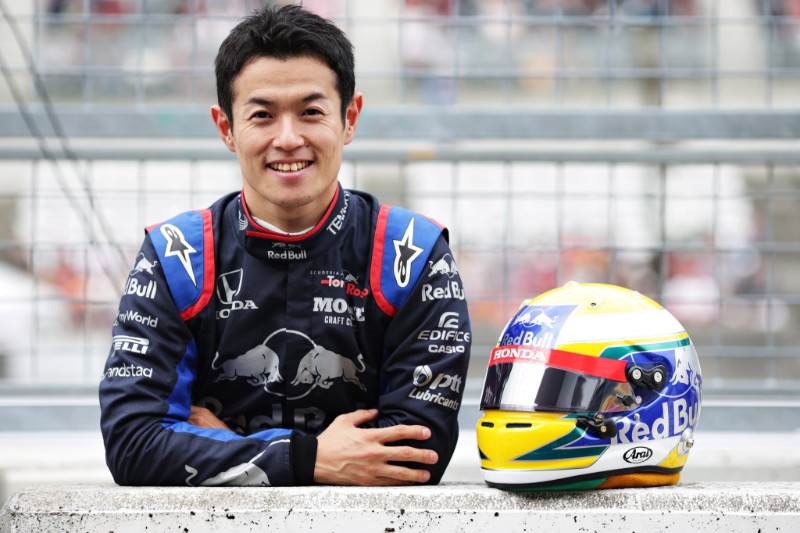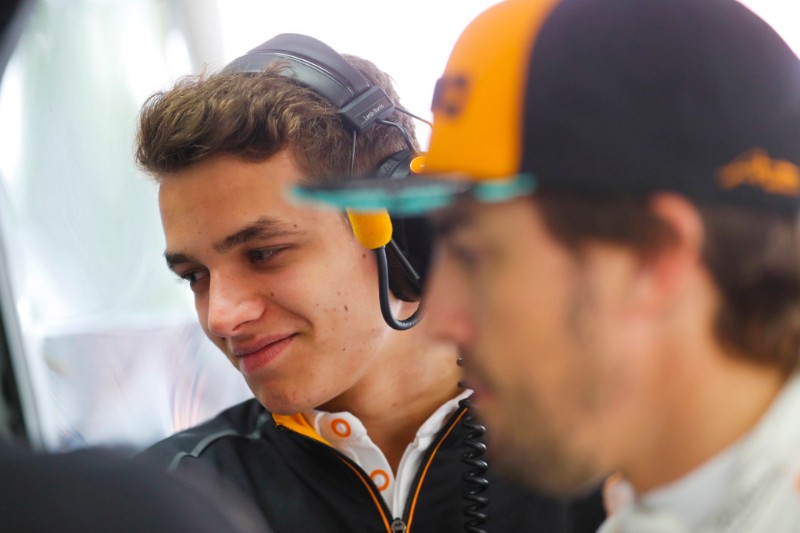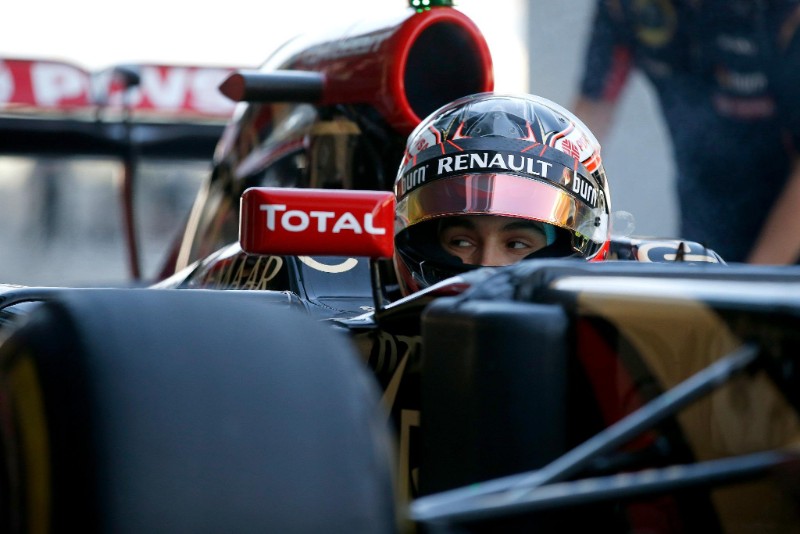
Photo: Honda Racing F1
The first free practice session on grand prix weekends is often used to trial drivers looking for a Formula 1 berth. While the time on track is not normally used to show outright lap time, a new name can still stand out
On Friday at Suzuka, Toro Rosso trialled two-time Super Formula and Super GT champion Naoki Yamamoto in FP1 for the Japanese Grand Prix. On his first run in an F1 car, he was just 0.098 seconds slower than team-mate Daniil Kvyat.
The 31-year-old, at times rumoured to be filling more than just a free practice-only role this weekend, ran more laps than anybody else and will return to Suzuka later this month as SF points leader in his pursuit of a third title.
Red Bull driver development boss Dr Helmut Marko has been in attendance at SF races and certainly has his eyes on Yamamoto: a driver who shares a nationality with Red Bull’s engine supplier Honda and possesses a mental fortitude that Marko maybe deems lacking in some of his other proteges.
It’s not impossible for him to be racing at Toro Rosso next year, given previous contradictory comments and decisions Red Bull has made about its driver plans, and FP1 is a perfect opportunity to judge the Japanese driver’s potential.
Five years ago, Red Bull played the same trick at Suzuka when it put 17-year-old Max Verstappen in at Toro Rosso for one session in place of Jean-Eric Vergne. He’d already secured his surprise F1 berth, and the rest – they say – is history. As well as Verstappen, here are four other young drivers who used their first practice-only appearance to make an F1 mark.
Max Verstappen TORO ROSSO was 17y/o
Japanese GP, October 3 2014. 12th fastest (+0.443s on team-mate)
To gain the FIA superlicence required to contest FP1 at Suzuka, Marko’s ‘new Senna’ spent a day at Adria in Italy the month before, in changing weather conditions, setting laps in Toro Rosso’s 2012 car.
The child sensation didn’t adapt seamlessly to contemporary machinery, struggling with gear and handling issues before his learning curve was cut by an engine failure. He recorded 22 laps and was 12th fastest, 0.443 seconds behind team-mate Daniil Kvyat.
Afterwards, Verstappen was frank about his experience. He admitted to not approaching the limit of the car around such a skill-heavy track, focusing on getting embedded in complex systems he would likely be using in 2015 and “driving safely”.
When questioned on his first experience of managing the hybrid powertrain, he replied with a comparison to PlayStation. Not surprising given he had turned 17 three days prior.
Analysis of the times that day showed Verstappen was actually up on Kvyat through sectors two and three on one run, and it’s no surprise that Verstappen called for the more experienced Jean-Eric Vergne to be retained for 2015 to learn from.
Verstappen oddly had an F1 seat before his first test, but by his third free practice appearance at Interlagos, where he saved a sideways car from spinning at Turn 12 to the amazement of Vergne, he had convinced people he deserved his place in F1.
Lando Norris McLAREN was 18y/o
Belgian GP, August 24 2018. 18th fastest (-0.088s on team-mate)
As his prize for winning the previous year’s Autosport BRDC Award, McLaren picked Lando Norris for the in-season Hungaroring test in 2017. He was the first award winner to get a run in a contemporary car, and became McLaren’s reserve driver at the end of the year.
He had to wait another year for his free practice debut at Spa-Francorchamps, during which time Red Bull made a meaningful approach for his services. The debut came not long after two-time world champion Fernando Alonso announced he would not be driving for McLaren in 2019, and it was clear immediately that Norris’s FP1 run was a rehearsal for a race seat.
Given the team’s struggles over the last few years, it was no surprise that Norris was three seconds off the pace, but he completed more laps and was faster than team-mate Stoffel Vandoorne, who was hit by brake and engine problems.
Most of Norris’s time was spent doing aero tests, and McLaren highlighted his “adaptability” given he was also racing in Formula 2 that weekend – the latter being Norris’s priority.
A second FP1 shot at Italy was hit by heavy rain, but Norris had already done enough for McLaren to make its decision and he was announced alongside Carlos Sainz Jr as one of its 2019 drivers just a few days later.
Anthony Davidson BAR?was 24y/o
Australian GP, March 5 2004. 9th fastest (+0.054s on team-mate)
Formula Ford Festival winner Anthony Davidson won the Autosport BRDC Award on December 3, 2000. A day later he was signed by an “extremely excited” British American Racing, based in Brackley, as its test driver for the next F1 season.
Davidson was beaten by Carlin team-mate Takuma Sato to the 2001 British Formula 3 title, but he did win the Pau Grand Prix. By October though, he had already decided to ‘end’ his two-year car racing career for a full-time BAR test role.
He’d gained over 12,000km of F1 mileage in 2002, as well as impress Team Green in a Champ Car test, when he received a surprise call to replace the underperforming Alex Yoong at Minardi for the Hungarian and Belgian Grands Prix.
His first FP1 appearance started badly, breaking the pitlane speed limit and clocking a fine 13 seconds in, and despite a transmission problem he outpaced highly rated team-mate Mark Webber. He spun out of both races, but his reputation only seemed to grow as Jaguar, Jordan and Toyota registered interest despite him being contracted to BAR for another year.
BAR signed Sato as reserve driver for 2003, and Davidson’s role was reduced. He was linked to seats elsewhere, but was adamant he would not pay for a drive when he had a paid role. More than once, BAR team principal David Richards reiterated Davidson was integral to his team and hoped he would remain there for 2004, when it could run a third car for free practice.
Despite his limited track time over the previous year, Davidson started the ’04 season ninth fastest in Australia and full of confidence. Days later, he was setting the pace in collective testing. Most circuits were new to Davidson, including Monaco – where he was outpaced by only Michael Schumacher. At Shanghai, a circuit known by nobody, he was fastest by 0.885s.
A contractual dispute stopped an opportunity with Williams, and BAR’s impressive ’04 meant it couldn’t run a third car in 2005. In 2007, Davidson finally got an F1 race deal with Super Aguri, but that ended after just over a season. He returned to Brackley as test and simulator driver, and has remained there ever since. The team is now known as Mercedes-Benz.
Paul di Resta FORCE INDIA was 23y/o
Australian GP, March 26 2010. 11th fastest (+0.345s on team-mate)
After winning the F3 Euro Series in 2006, Paul di Resta was snatched by the DTM and was a staple of Mercedes’ factory line-up from 2008-’10. In 2009, the manufacturer started a relationship with Force India as an F1 engine customer, and at the end of the year it tested di Resta against Indy Lights champion J. R. Hildebrand in the first ever bespoke young driver test.
Force India effectively used it as a shootout to become its 2010 reserve, with di Resta prevailing. From the off, the idea was that in that position he would also take over from one of the regular drivers in free practice when it did not clash with DTM.
The team’s desire was to nurture di Resta’s talent in that role too, with his test and free practice programme designed to benefit him as much as the team. This also included exposure to F1 standard public relations, the first instance of which was unintentionally meeting a shark near a beach in Australia.
Given Melbourne’s unique nature as a circuit, it was an odd and difficult to prepare for choice as di Resta’s first FP1 appearance. Not only that, but it was also his first taste of Force India’s car in dry conditions.
A lengthy 25-lap run resulted in 11th place on the timesheet, and a very happy team as di Resta’s set-up data proved crucial. Most of the circuits were new to di Resta, including Silverstone, but that high start meant he was linked to a 2011 race seat (which he got) very quickly. His F1 learning curve helped his DTM results too, as he took Mercedes’ first title since 2006.
Esteban Ocon LOTUS was 18y/o
Abu Dhabi GP, November 21 2014. 16th fastest (+0.355s on team-mate)
As is standard with ‘Team Enstone”s young drivers, Esteban Ocon’s first F1 test came in Lotus’s 2012 car, and he more than impressed those who were present. Only just 18, the Frenchman immediately made his case to be in that year’s car.
In 2014, F1 introduced turbocharged 1.6-litre V6 turbo engines and hybrid components, and it took the teams as much learning as the drivers to understand the complex powertrain systems and how to manage them while on-track.
Recently crowned European F3 champion Ocon, who had beaten Verstappen to the title, was hot property and running him in the final free practice session of the season was supposed to be a clear sign that Lotus’s junior would be remaining there.
He was just over a third of a second off Pastor Maldonado in his single session, and the team was once again massively pleased with the job he had done in a car very different to drive compared to the 2012 chassis. Lotus was convinced that Ocon could competently step in on a grand prix weekend, and hired him as reserve for 2015.
Rival teams had eyes on Ocon, and Lotus advertising his strength of feedback after FP1 only made him more desirable.
Lotus’s failure to get Ocon in GP2 left him with ART Grand Prix in GP3 for ’15. It was a title-winning solution, but one made possible thanks to Mercedes, which quickly pinched him as its DTM reserve. The manufacturer had supported him in European F3, and it was clear its renewed interest in him lied in F1 when he was called up to test for Force India within days of signing.
He wasn’t officially a Mercedes F1 junior until November, but was loaned back to Renault (nee Lotus) over the winter before joining Mercedes’ DTM line-up. After four FP1 appearances with Renault, Ocon raced for Manor in the final nine races, with the French manufacturer expecting him to be free to race for it in 2017. Three years later, it eventually got its way.
George Russell FORCE INDIA was 19y/o
Brazilian GP, November 10 2017. 12th fastest (+0.593s on team-mate)
Mercedes junior George Russell had already clinched the 2017 GP3 title when he got his first F1 free practice call-up, meaning there were no excuses for struggling to adapt to both types of car like predecessor as champion Charles Leclerc had.
His opportunity with Force India at Interlagos came after sampling Mercedes’ title-leading car in the in-season Hungaroring test when its race drivers weren’t available to use. Unlike Leclerc, Russell seemed to benefit directly – and almost instantly – in GP3 from busying himself in F1-related activities, which included trialling the halo cockpit protection device.
Mercedes deliberately put Russell on free practice programmes that denied one-lap glory, a useful method of eyeing maturity given any driver with the fastest car on the grid would by right want to go as fast as possible.
When his FP1 debut came, with a different team, he fitted in seamlessly and had barely got out of the car before Force India were asking Mercedes whether they could keep him as reserve driver for 2018. Without explicitly saying it, every description given of Russell’s performance was to suggest that he was race-ready, including comparisons with the team’s existing line-up.
A financial package from Nicholas Latifi denied him a formal position there, and he turned down a singular FP1 offer to concentrate on winning the F2 title. A return Hungaroring visit in 2018 resulted in an unofficial track record, and Russell efficiently used the press to highlight his credibility as a F1 prospect.
It got to the point where Mercedes team principal Toto Wolff was calling for three-car F1 teams to race so he could accommodate Russell, a piece of hyperbole that was part of a two-hander between the pair and the media.
Nearly 12 months of hype, which had built up from his FP1 cameo in Brazil, coupled with his headline-grabbing F2 results and a sharp mind resulted in Russell convincing Williams to sign him on a multi-year deal.

Yamamoto may be no young driver, but he’ll know of the opportunities a single session can lead to











